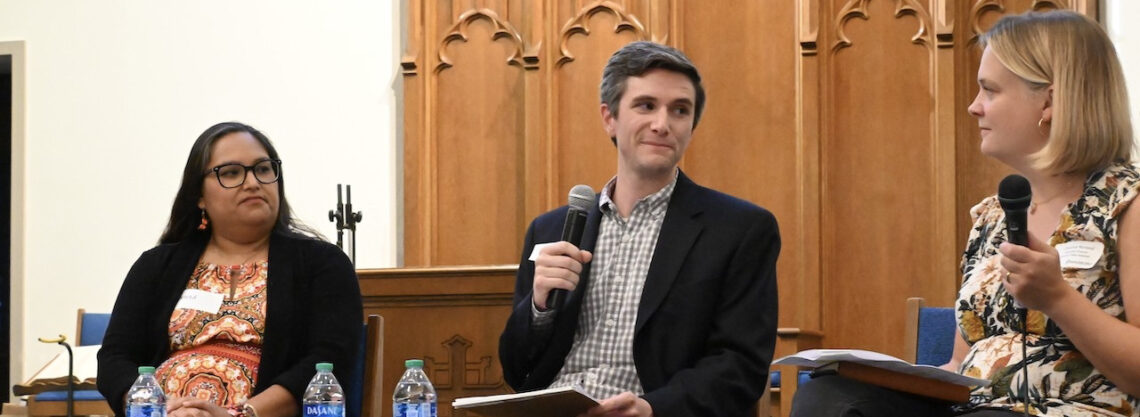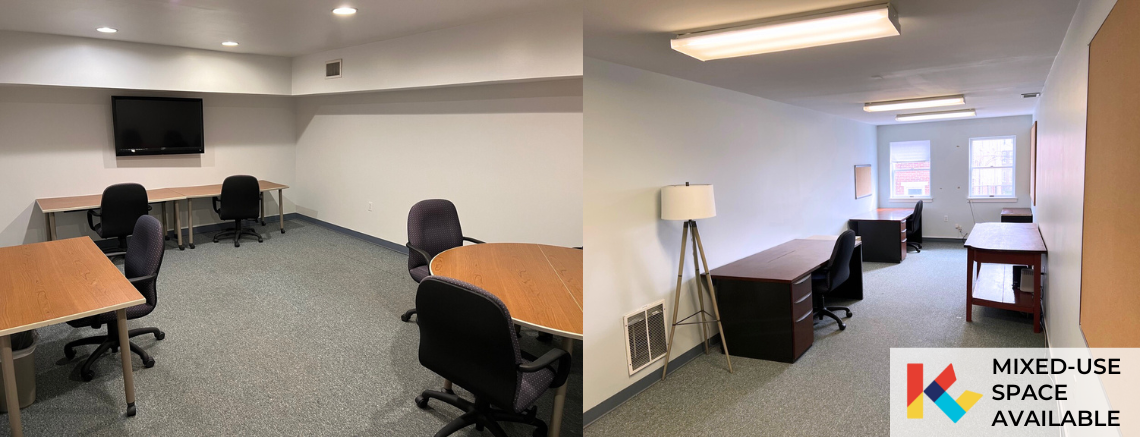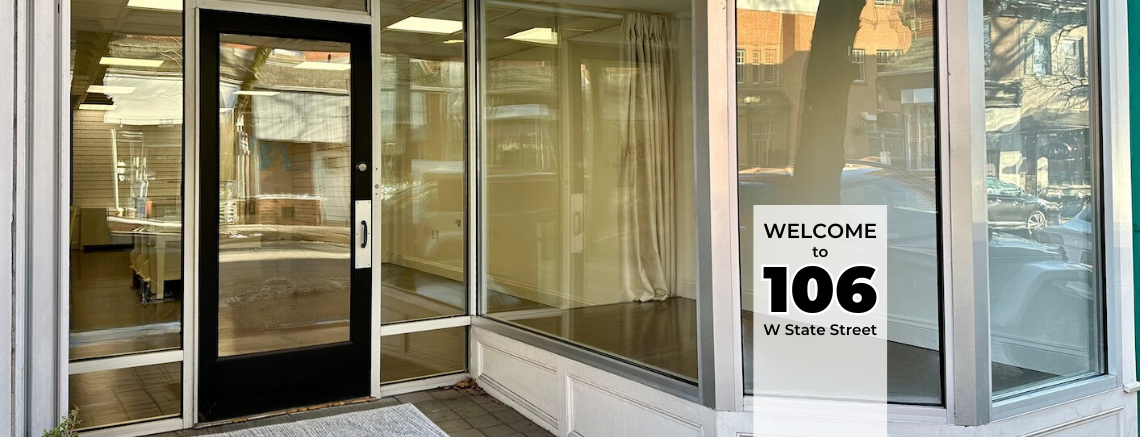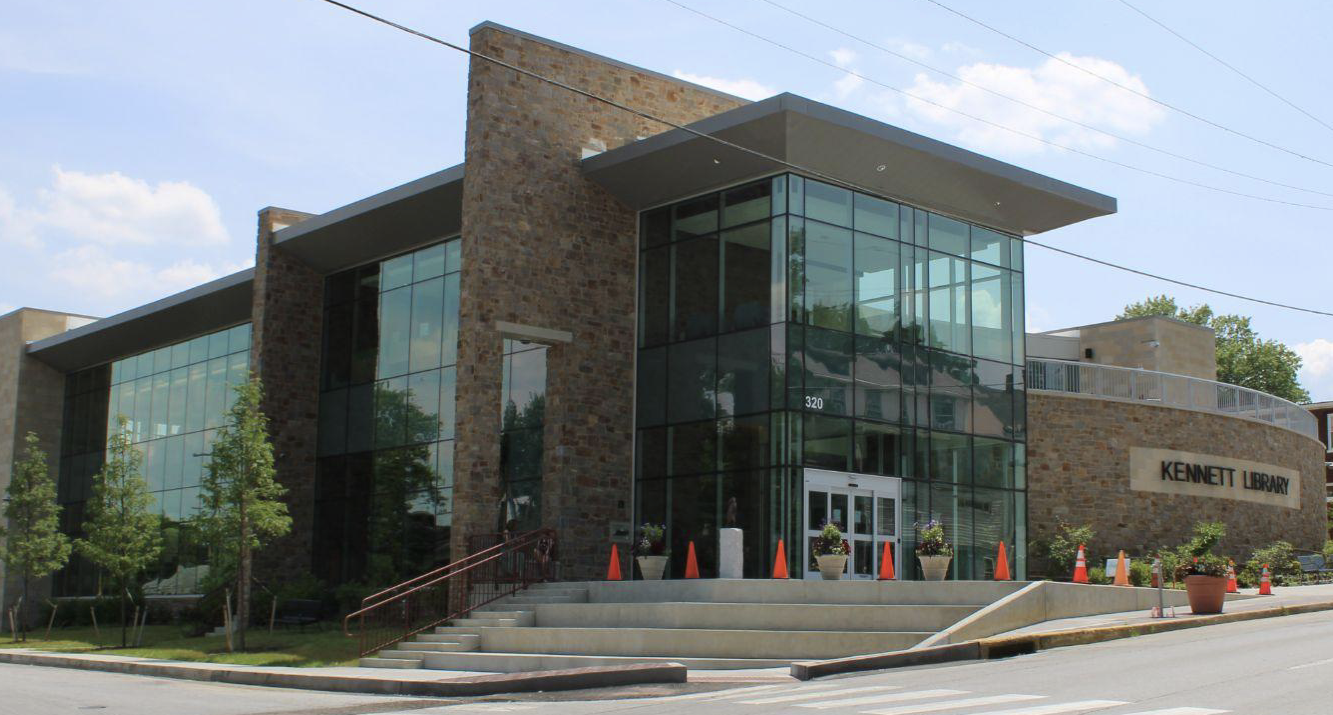Community members gathered last Thursday evening for an engaging and thought-provoking conversation with three fellows from the Kennett Emerging Leaders program. Elideth Navarro, Mayra Castillo, and Lee Sausen talked about belonging, inclusivity, and building the kind of social infrastructure that’s the necessary foundation for equitable and inclusive communities.
Navarro shared how disorienting and traumatizing it was to move here from Guerrero, Mexico at age fourteen and to start school without knowing the language. A full twenty years later, she describes the Kennett Emerging Leaders program as the welcome experience she never had. “It was the hug you always expect to receive when you get to a new place,” she said. “It was a safe environment where I could bring my whole self and not be afraid to speak up.”
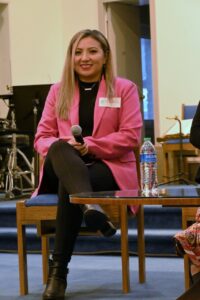
Kennett Emerging Leaders program fellow Elideth Navarro describes her experience of finally feeling welcome here. (Photo: Raúl Toledo)
Castillo, who spoke of the stark inequities exposed by the pandemic, used the saying “No soy de aquí ni soy de allá” (I’m not from here, I’m not from there) to describe her complicated experience of living in this country for nearly thirty years. The creation of a theater piece for one of the Emerging Leaders workshops brought a defining moment for her and other participants who also felt—for various reasons including skin color, language barriers, or even being from another place in the US—that they didn’t belong here.
“You have to say ‘I belong here’ and you really have to believe it: ‘I belong. I belong here,’” Castillo said. Even in her role as a leader and as Coordinator of Student Diversity and Inclusion at Cecil College, Castillo finds she still walks into rooms where she needs to remind herself: “I belong here.”
This sense of belonging will look different for everyone. “Every single one of us looks at community and our role in the community slightly differently,” said Sausen. What we all share, said PennPraxis researcher and Emerging Leaders team member Katie Levesque, is the ability to take small steps “to shift and share power among everyone who lives in the community” so we can create the kinds of places we collectively want.
Following the discussion on Thursday evening, a reception highlighted several community projects at various stages of development that are working to address these issues of belonging.
Here are five quick-action steps you can take to get more involved and help make our community more inclusive:
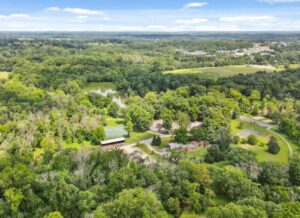
Great plans are in the works for transforming the historic Water Works buildings at Anson B. Nixon Park.
1. Save the date for the Kennett Area Park Authority (KAPA) Community Meeting on Tuesday, October 18th at 6:30pm at The Creamery to learn more about future plans to transform the historic Water Works buildings at Anson B. Nixon Park. Community members will have the opportunity to give input on this important project that is designed to serve our growing community. Find out more here.
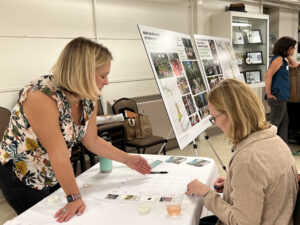
Kennett Trails Alliance is seeking public input on their plans for Red Clay Park.
2. Take this survey to give input on what you’d like to see in the future Red Clay Park, which is now fully funded thanks to a recent grant award from the Greenways, Trails, and Recreation Program (GTRP). You can also check out the Kennett Trails Alliance website for information about creative and engaging community events coming soon!

South Broad Partnership’s proposed project for 600 South Broad Street would offer attainable housing, beautiful and vibrant public spaces, and retail spaces that provide opportunities for entrepreneurs.
3. Winston Churchill once said: “We shape our buildings, and afterwards our buildings shape us.” We have the power to shape our places. In the throes of a loneliness epidemic, the fact that our places shape the way we interact with others is a particularly poignant call to action.
Our places also have the power to inspire or deaden the life within us and shape our trajectory and opportunities in life. South Broad Partnership’s proposed project for 600 South Broad Street would provide a model for how a community can offer attainable housing, beautiful and vibrant public spaces, and retail spaces that provide opportunities for entrepreneurs—while also preserving the character of historic buildings and incorporating beautifully and well-built new construction in a diverse and thoughtfully designed neighborhood.
Public support for this out-of-the-box, forward-thinking project that will also be a model for other communities will be vitally important. Please sign up here to receive periodic updates on the project.
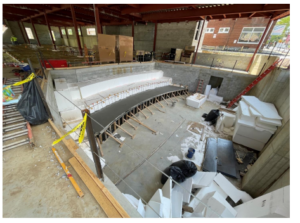
The auditorium in the new Kennett Library is taking shape!
4. The Kennett Library offers an amazing array of resources and programs, and the new Library & Resource Center will offer even more. You can support their campaign here—and you can find a great event, program, or activity to get involved in here.
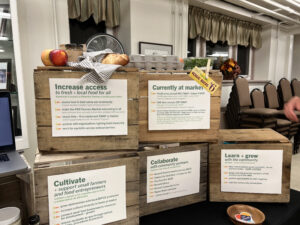
The KSQ Farmers Market is working towards increased diversity and access to fresh, local food for all.
5. Not only does the KSQ Farmers Market enable local farmers and producers to sell their products directly to consumers every Friday. The market is also actively engaged in growing access to fresh, local food for all through programs like SNAP, in cultivating relationships to increase the cultural diversity of vendors and foods at the market, supporting local organizations like KACS, addressing issues of food justice, and more. Support our local economy from 3pm to 6pm The Creamery on Birch Street. Sign up for the KSQ Farmers Market weekly email—with updates on vendors and more—here.
The Kennett Square Emerging Leaders Program was a partnership between PennPraxis and Square Roots Collective to develop new, inclusive, and actionable ways to engage the wider Kennett community and strengthen Kennett’s social infrastructure.
“The purpose of all architecture is to encourage and support life-giving activity, dreams, and playfulness. But in recent decades, while our buildings are technically better—more sturdy, more waterproof, more energy efficient—they have also became progressively more sterile, rarely providing the kind of environment in which people are emotionally nourished, genuinely happy, and deeply contented.”
—Christopher Alexander (British-American architect, author, and design theorist)
“Cities have the capability of providing something for everybody, only because, and only when, they are created by everybody.”
—Jane Jacobs (American-Canadian journalist, author, theorist, and activist)
